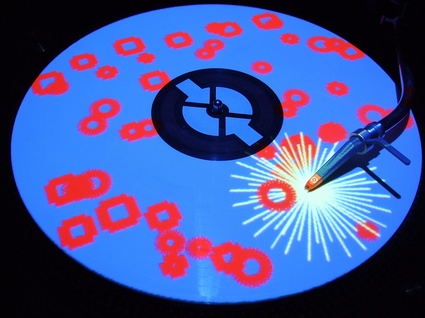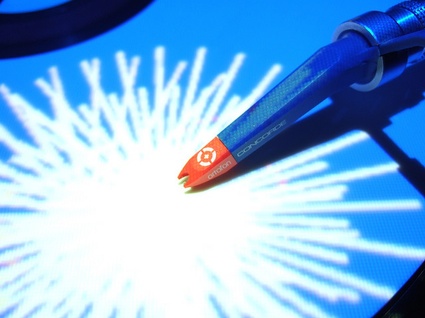From what i’ve seen the other week in Sao Paulo, FILE, the International Festival of Electronic Language, is extremely popular with the broad public. It’s easy to understand why. The event is not only free, it also offers extremely good works and mainstream entertainment (a few pieces even manage to be both). Some works delighted me, others made me want to dedicate this blog to Ukrainian cuisine (which is actually very good.) But that happens with most media art festivals i attend.
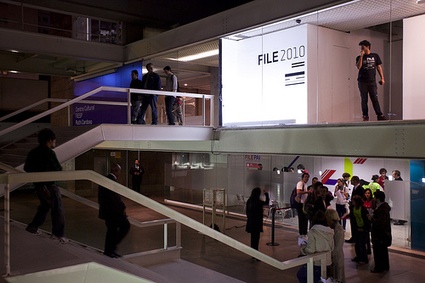
Far from being confined to the stern white walls of the Sesi Paulista’s cultural space, FILE has also invaded the whole Paulista Avenue with animations, artistic interventions, interactive installations and screening. They wait for passersby in bookstores, subway stations, buses or on the facade of the buildings.
Just a few shots from FILE PAI – Paulista Avenue Interactive before i focus on the main exhibition:
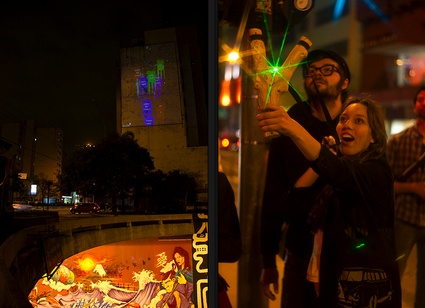 VR/URBAN, SMS Slingshot
VR/URBAN, SMS Slingshot
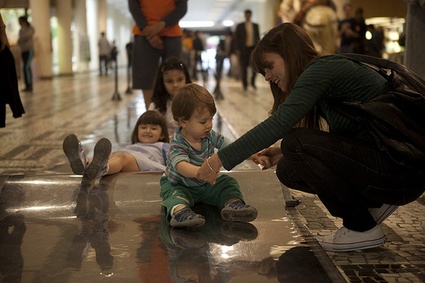 Rejane Cantoni & Leonardo Crescenti, Piso
Rejane Cantoni & Leonardo Crescenti, Piso
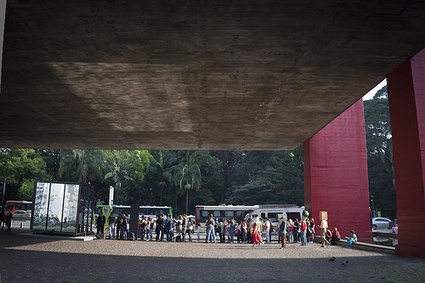
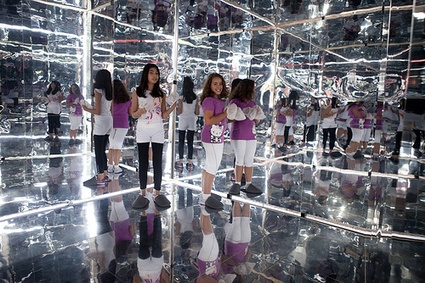 Rejane Cantoni & Leonardo Crescenti, Infinito Ao Cubo / Infinite Cubed
Rejane Cantoni & Leonardo Crescenti, Infinito Ao Cubo / Infinite Cubed
Unlike many of similar art and tech festivals in Europe, the FILE exhibition doesn’t have a theme, its main objective is to showcase and promote some of the most exciting artistic productions in the field of electronic and digital arts. The sound installations were outstanding. My little round-up of the exhibition will try to do them justice. If you’d like to discover more of them, head to the Electronic Sonority section of the FILE Prix Lux website.
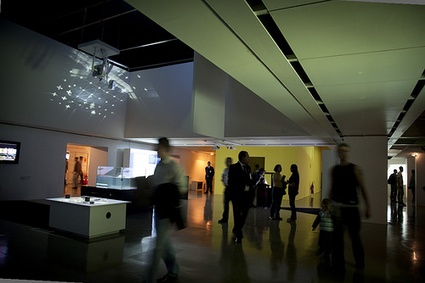
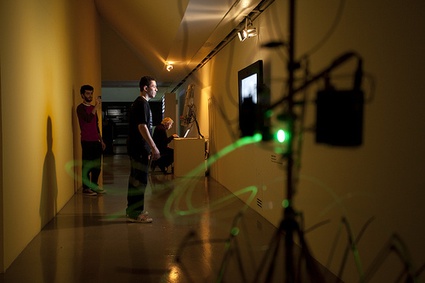 Jonas Bohatsch‘s v+ (expanded timecode vinyl) is a seemingly blank record. Sound and animations emerge when its needle hits one of the light forms projected onto the vinyl.
Jonas Bohatsch‘s v+ (expanded timecode vinyl) is a seemingly blank record. Sound and animations emerge when its needle hits one of the light forms projected onto the vinyl.
The artist describes his work as follows: vinyl+ tries to expand timecode vinyl, usually used for digital djing, with visual and interactive elements. This is accomplished by sending the turntables rotational speed and needle position to a processing sketch. This sketch then generates corresponding visual output on the surface of the vinyl itself.
Jonas Bohatsch, v+
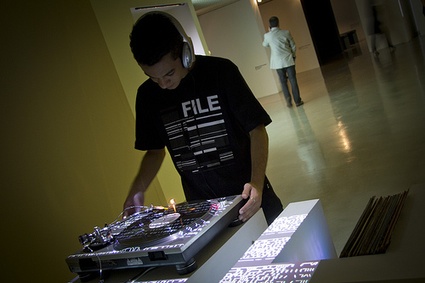 METROBANG, by Ricardo Brasileiro, turns the frequencies and noise from vinyl records into a sequence of synthesis of low and granular synthesis (i’m merely copy/pasting, to be honest i was amazed by the result but i’m not sure i understand fully the how and why.) Musicians can change speed, volume, pitch and other effects with the touch of the instrument and by changing disks. The frequencies of the disck are simultaneously displayed in ASCII format on the computer terminal.
METROBANG, by Ricardo Brasileiro, turns the frequencies and noise from vinyl records into a sequence of synthesis of low and granular synthesis (i’m merely copy/pasting, to be honest i was amazed by the result but i’m not sure i understand fully the how and why.) Musicians can change speed, volume, pitch and other effects with the touch of the instrument and by changing disks. The frequencies of the disck are simultaneously displayed in ASCII format on the computer terminal.
Ricardo Brasileiro, Metrobang
Jörg Piringer created an application for iPhone & iPod touch that allows you to create and control different groups of tiny sound-creatures in the shape of letters. They have several kinds of behaviour, some being more aggressive or gregarious than others for example, that react to gravity or to each other and generate rhythms and soundscapes.
Jörg Piringer , [abcdefghijklmnopqrstuvwxyz]
From Dust Till Dawn, by Markus Decker, Dietmar Offenhuber and Ushi Reiter, is a dark room with a fluorescent glow and a broom up against a wall. Phonographs are playing back silent vinyl records. The fluorescent mist is actually made of particles of dust. As visitors move through the room, the particles swirl up and some of it accumulate in the grooves of the records and define a musical score. A carpet of monochromatic light visualizes the turbulence in the atmosphere and detects its ephemeral structures, which are directly linked to the noise generated by the dusty records. Over time, the physical impact of the interaction irreversibly consumes the interface and destroys the needles of the phonographs. (if dusty floors make you happy, check out The Dustbunnies, by Stijn Schiffeleers and Hendrik Leper from Boutique Vizique.)
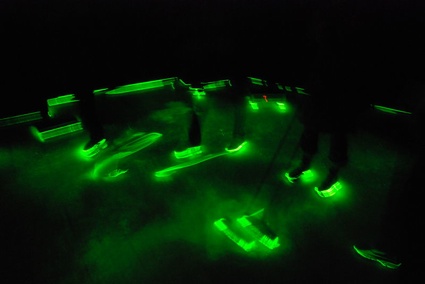 Robert Mathy‘s Light Frequency Fingertips is a musical instrument composed of four fingercaps which transform light frequencies emitted by the displays of mobile phones into acoustic signals that can be mixed and faded during live performances.
Robert Mathy‘s Light Frequency Fingertips is a musical instrument composed of four fingercaps which transform light frequencies emitted by the displays of mobile phones into acoustic signals that can be mixed and faded during live performances.
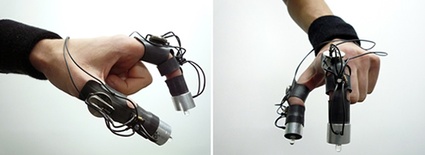
Robert Mathy, Light Frequency Fingertips
The winner of the Interactive Art section of the FILE Prix Lux awards is Ernesto Klar with his installation Relational Lights.
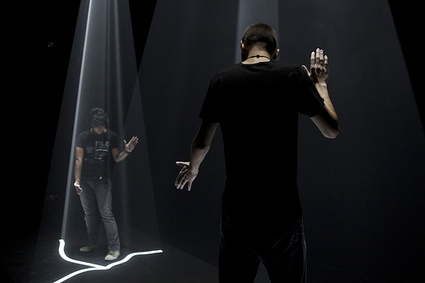 Ernesto Klar, Luzes relacionais / Relational Lights
Ernesto Klar, Luzes relacionais / Relational Lights
The work turns the light setting into a organism that can both live on its own or interact with spectators when they enter the roon. When viewers are outside the active tracking area, the system dialogue with the space by extruding and morphing sequences of geometric light forms. As soon as visitors enter the projected light-space, a collective and participatory expression of space unfolds.
Ernesto Klar, Luzes relacionais / Relational Lights
Frame Seductions, by Pierre Proske, explores the concept of looking outside of the video frame by tracking the head movements of people in front of the screen. Only a static but very seducing image can be seen from the distance but as visitors come nearer and turn their head to the left or to the right the perspective of the video on the screen automatically follows their gaze, enabling them to access material that would otherwise be outside of the filming frame. Viewers can this discover quirky scenarios lurking in the sidelines: characters appear in several places at once, exit through doors to reappear elsewhere and sometimes give the viewer or each other quizzical looks.
This neat little video is much clearer than a description:
Pierre Proske, Frame Seductions
The media art festival brought the high brow and the low brow under the same roof. Enters Mood Tail, by Wei-Chieh Tseng. Do you really need me to elaborate on it?
Wei-Chieh Tseng, Mood Tail

